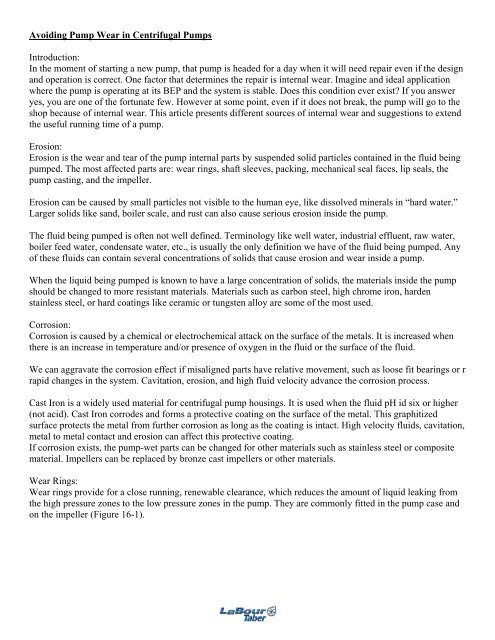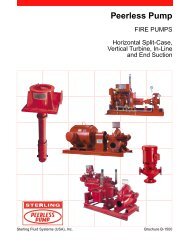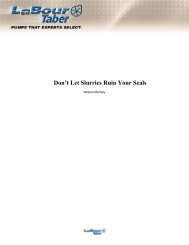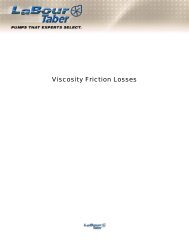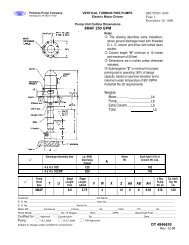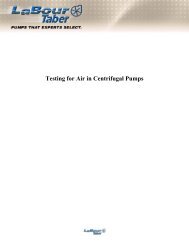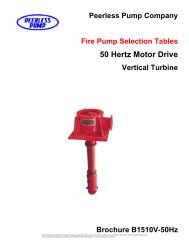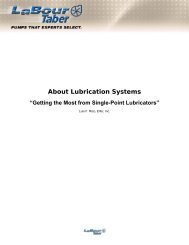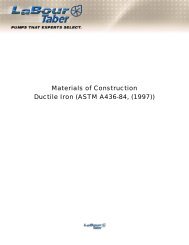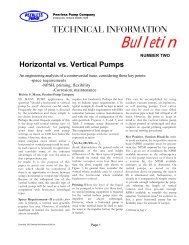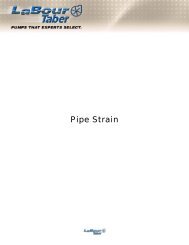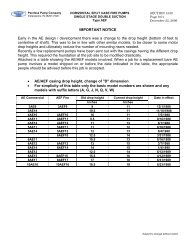Create successful ePaper yourself
Turn your PDF publications into a flip-book with our unique Google optimized e-Paper software.
Avoiding <strong>Pump</strong> <strong>Wear</strong> in Centrifugal <strong>Pump</strong>sIntroduction:In the moment of starting a new pump, that pump is headed for a day when it will need repair even if the designand operation is correct. One factor that determines the repair is internal wear. Imagine and ideal applicationwhere the pump is operating at its BEP and the system is stable. Does this condition ever exist? If you answeryes, you are one of the fortunate few. However at some point, even if it does not break, the pump will go to theshop because of internal wear. This article presents different sources of internal wear and suggestions to extendthe useful running time of a pump.Erosion:Erosion is the wear and tear of the pump internal parts by suspended solid particles contained in the fluid beingpumped. The most affected parts are: wear rings, shaft sleeves, packing, mechanical seal faces, lip seals, thepump casting, and the impeller.Erosion can be caused by small particles not visible to the human eye, like dissolved minerals in “hard water.”Larger solids like sand, boiler scale, and rust can also cause serious erosion inside the pump.The fluid being pumped is often not well defined. Terminology like well water, industrial effluent, raw water,boiler feed water, condensate water, etc., is usually the only definition we have of the fluid being pumped. Anyof these fluids can contain several concentrations of solids that cause erosion and wear inside a pump.When the liquid being pumped is known to have a large concentration of solids, the materials inside the pumpshould be changed to more resistant materials. Materials such as carbon steel, high chrome iron, hardenstainless steel, or hard coatings like ceramic or tungsten alloy are some of the most used.Corrosion:Corrosion is caused by a chemical or electrochemical attack on the surface of the metals. It is increased whenthere is an increase in temperature and/or presence of oxygen in the fluid or the surface of the fluid.We can aggravate the corrosion effect if misaligned parts have relative movement, such as loose fit bearings or rrapid changes in the system. Cavitation, erosion, and high fluid velocity advance the corrosion process.Cast Iron is a widely used material for centrifugal pump housings. It is used when the fluid pH id six or higher(not acid). Cast Iron corrodes and forms a protective coating on the surface of the metal. This graphitizedsurface protects the metal from further corrosion as long as the coating is intact. High velocity fluids, cavitation,metal to metal contact and erosion can affect this protective coating.If corrosion exists, the pump-wet parts can be changed for other materials such as stainless steel or compositematerial. Impellers can be replaced by bronze cast impellers or other materials.<strong>Wear</strong> Rings:<strong>Wear</strong> rings provide for a close running, renewable clearance, which reduces the amount of liquid leaking fromthe high pressure zones to the low pressure zones in the pump. They are commonly fitted in the pump case andon the impeller (Figure 16-1).


